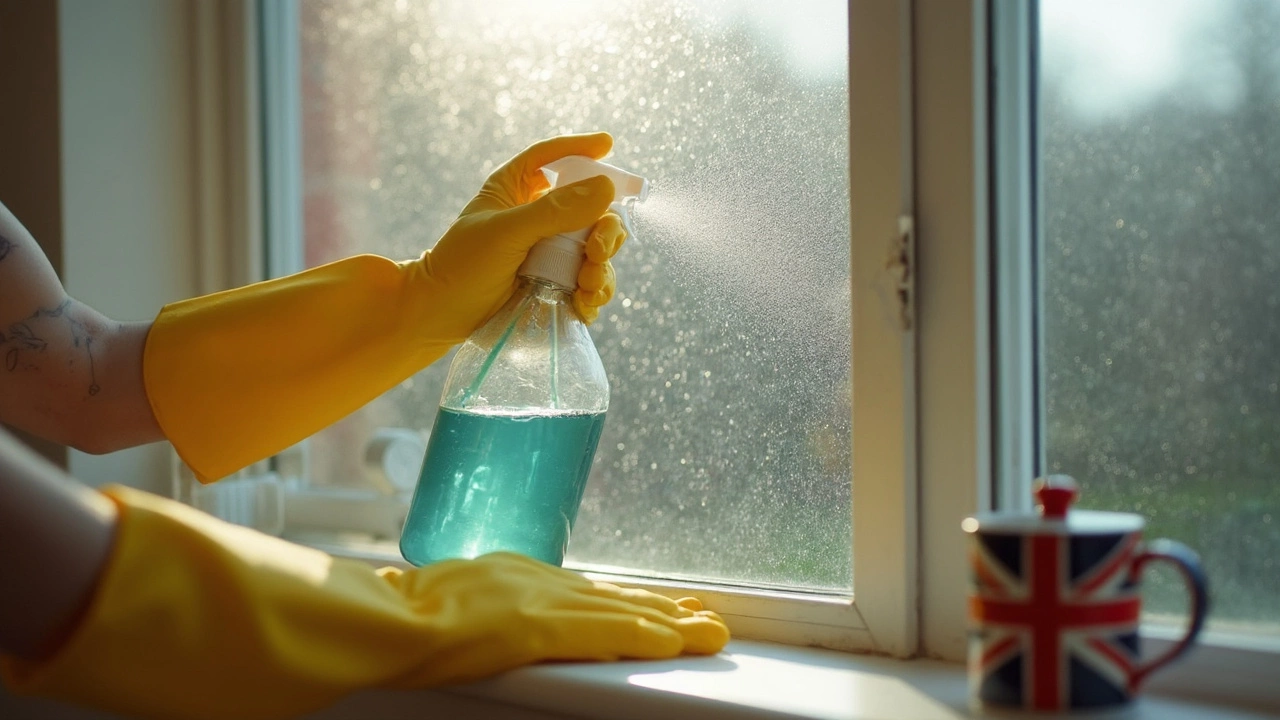Ever notice how fancy window cleaning products seem to do about the same job as plain old household stuff? Here’s the thing—most windows don’t need expensive sprays or high-tech gadgets to look clean. You actually have everything you need right at home, and the results can be just as good as the pro stuff.
Start by looking at what you already have—maybe some vinegar under the sink, an old spray bottle, a squeegee you barely use, or even yesterday’s newspaper. Those basic items? They knock out dirt, smudges, and that cloudy film for almost no money.
Before you even grab your cleaner, dust the window edges and sills. If you skip this, dirt just turns into streaky mud when you get the glass wet. Quick wipe with a dry rag saves time and avoids making more mess.
- Skip the Expensive Products
- DIY Cleaning Solutions that Work
- Tools You Already Own
- No-Streak Tricks for Any Budget
Skip the Expensive Products
Big brands want you to believe you need their bottles and sprays to get your windows truly spotless, but here's the reality: those $5-$10 store-bought cleaners mostly have the same main ingredient as vinegar—acetic acid—diluted in water. Some even just add blue dye to catch your eye. According to Consumer Reports, homemade mixes clean just as well for a fraction of the price.
You can easily mix your own cleaner at home. Grab these basics:
- White vinegar (about $2 per quart)
- Tap water
- A spray bottle (reuse an old one)
For regular smudges, a simple ratio works:
- 2 cups water
- 1/2 cup white vinegar
For extra greasy messes or years of build-up, add a drop of dish soap to the mix. Just don’t go wild, or you’ll be rinsing bubbles forever.
Curious about how costs stack up? Here’s a quick look:
| Cleaner Type | Average Cost (per use) |
|---|---|
| Brand Name Spray | $0.80 |
| DIY Vinegar Mix | $0.07 |
| Soap & Water | $0.10 |
Big saving for the same outcome, right?
Don’t fall for marketing. A cheap window cleaning mix made in your kitchen clears off fingerprints, bird droppings, and handprints with no chemical smell or smears. Plus, if you’ve got pets or kids, vinegar-based sprays are a safer bet. The bottom line: store-bought isn’t better. You can save money and avoid pointless chemicals.
DIY Cleaning Solutions that Work
You don’t need anything fancy for squeaky-clean windows—just a few things most people already have in their kitchen. Vinegar is by far the champion when it comes to homemade window cleaner. Science backs it up too: vinegar (acetic acid) breaks down grease and grime.
- Cheap window cleaning starts with a simple mix: one part white vinegar to one part warm water. Pour that into a spray bottle and you’re good to go. If your windows are extra dirty, add a little squirt of dish soap to the mix for extra power.
- Lemon juice works almost as well as vinegar. It cuts through mineral deposits and leaves a nice fresh smell. Mix three tablespoons of lemon juice in a quart of water—great for cleaning and makes your hands smell nice too.
- If you don’t want to mess with liquids, try dry newspaper. It’s got just the right texture to scrub away grime and it won’t leave lint behind like paper towels. Just crumple up a sheet and wipe down after spraying your solution.
Here’s a quick look at what people use in their homemade mixes and what they cost per cleaning:
| Ingredient | Average Cost per Use | Bonus |
|---|---|---|
| White Vinegar | $0.10 | Removes hard water |
| Lemon Juice | $0.25 | Cuts through streaks, smells fresh |
| Dish Soap | $0.05 | Handles oily residue |
| Newspaper | Free (if you have an old one) | No lint left behind |
If your glass is super foggy or sticky, spray on your DIY mix and let it sit for a minute before wiping. This gives it time to loosen up whatever’s stuck on there. For the outside, go for cloudy days—cleaner dries slower, so you won’t get as many streaks.

Tools You Already Own
Forget buying a bunch of new gear. Cheap window cleaning starts with regular household items that actually work. There’s no rule saying you need pro gear or fancy microfiber cloths. The best part? Most tools people buy just collect dust while basics get the job done.
For the main part of cleaning, grab some of these from around your place:
- Cheap window cleaning staple: Old cotton t-shirts. These are soft enough that they won’t scratch glass and they don’t leave lint behind.
- Newspapers—seriously, the black-and-white pages buff windows to a shine and don’t streak once they dry.
- A basic squeegee: If you have one, use it! It makes a huge difference, especially for bigger windows, and cuts your drying time to almost nothing.
- Spray bottle: You’ll want this for your cleaning mix. If you don’t have one, rinse out an old bottle from another cleaner and you’re good to go.
- Bowl or bucket: For bigger jobs, dump your cleaning mix here. It doesn’t need to be fancy, just clean.
- Soft rag or cloth: Skip the paper towels, which can leave fuzz and get expensive fast. Old rags or even cloth diapers do better.
Here’s a quick breakdown comparing some of the most common household window tools versus store-bought ones:
| Tool | Cost (Average) | How Well It Works |
|---|---|---|
| Old T-shirt | $0 (already owned) | No lint, gentle, reusable |
| Newspaper | Free or pocket change | Super shiny finish, no streaks |
| Paper Towels | $2-$4/roll | Leaves lint, not reusable |
| Microfiber Cloth | $4-$8 each | Works great but pricier, not always necessary |
| Squeegee | $5-$15 one-time | Fast, leaves glass really dry |
Think about it: the stuff in your laundry basket or recycling bin can help you out for no extra money. And if you go the squeegee route, it’ll last for years with just a quick rinse after each use. No need to splurge when the basics are already sitting in your house.
No-Streak Tricks for Any Budget
Streaks are usually what makes window cleaning frustrating. But here’s the thing—if you follow a few simple methods, you’ll end up with perfect glass no matter how cheap your tools are. One tip straight from professional cleaners: always clean windows on a cloudy day or when the sun isn’t hitting the glass. Why? Because heat dries cleaner too fast, leaving streaks behind.
When you use your DIY cleaner (like a mix of water and vinegar), use just a little on the glass. If you soak the window, you’ll end up with drips that dry before you can wipe them off. Less is more here.
- Use a microfiber cloth instead of paper towels. Microfiber leaves less lint and does a better job wiping off grime. If you only have old tee shirts, those work surprisingly well too.
- The classic newspaper trick? It really works. The paper has just enough grit to wipe away leftover cleaner, and it doesn’t leave fibers behind. Just be careful with wood frames—newsprint ink can rub off.
- Always wipe in a Z-shaped motion instead of circles or straight lines. This helps cover the whole window and avoids re-smudging the areas you’ve already wiped.
- Change your cloth or paper often. If it’s too wet or dirty, you’re just spreading stuff around instead of cleaning. Don’t get lazy about this part—it actually makes a difference.
If you’re serious about a cheap window cleaning routine, get or borrow a simple rubber squeegee. The key is to start at the top and pull straight down, wiping the blade with a dry rag between swipes. No fancy moves, just gravity helping you out. Squeegees not only speed things up but really leave zero streaks when you use them right.
Look at the window from different angles before you call it done. Smudges and streaks hide until the light changes. A few seconds checking now saves you double work later.
